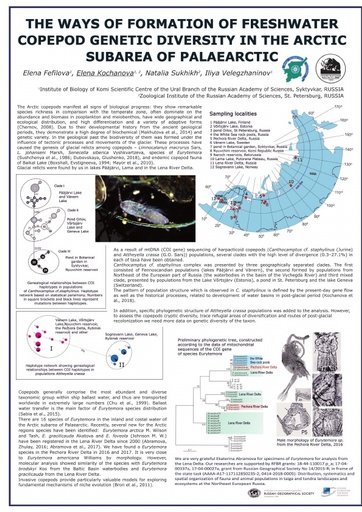pdf The ways of formation of freshwater copepod genetic diversity in the Arctic subarea of palaearctic Popular
1782 downloads

Elena Kochanova
Elena Fefilova, Natalia Sukhikh, Iliya Velegzhaninov
Institute of Biology Komi SC UB RAS, Zoological Institute of the RAS
 The Arctic copepods manifest all signs of biological progress: they show remarkable species richness in comparison with the temperate zone, often dominate on the abundance and biomass in zooplankton and meiobenthos, have wide geographical and ecological distribution, and high differentiation and a variety of adaptive forms. In the geological past the biodiversity of them was formed under the influence of tectonic processes and movements of the glacier. As a result of mt DNA (COI gene) sequencing of harpacticoid copepod populations, several clades with the high level of divergence in each of taxa have been obtained. Copepods generally comprise the most abundant and diverse taxonomic group within ship ballast water, and thus are transported worldwide in extremely large numbers. And Eurytemora species dominant in the ballast water among copepods. Recently, several new for the Arctic regions species have been identified: Eurytemora arctica M. Wilson and Tash, E. gracilicauda Akatova and E. foveola (Johnson M. W.) have been registered in the Lena River Delta since 2000 (Abramova, Zhulay, 2016; Abramova et al., 2017).We have found a Eurytemora species in the Pechora River Delta in 2016 and 2017. It is very close to Eurytemora americana Williams by morphology. However, molecular analysis showed similarity of the species with Eurytemora brodskyi Kos from the Baltic Basin waterbodies and Eurytemora gracilicauda from the Lena River Delta.
The Arctic copepods manifest all signs of biological progress: they show remarkable species richness in comparison with the temperate zone, often dominate on the abundance and biomass in zooplankton and meiobenthos, have wide geographical and ecological distribution, and high differentiation and a variety of adaptive forms. In the geological past the biodiversity of them was formed under the influence of tectonic processes and movements of the glacier. As a result of mt DNA (COI gene) sequencing of harpacticoid copepod populations, several clades with the high level of divergence in each of taxa have been obtained. Copepods generally comprise the most abundant and diverse taxonomic group within ship ballast water, and thus are transported worldwide in extremely large numbers. And Eurytemora species dominant in the ballast water among copepods. Recently, several new for the Arctic regions species have been identified: Eurytemora arctica M. Wilson and Tash, E. gracilicauda Akatova and E. foveola (Johnson M. W.) have been registered in the Lena River Delta since 2000 (Abramova, Zhulay, 2016; Abramova et al., 2017).We have found a Eurytemora species in the Pechora River Delta in 2016 and 2017. It is very close to Eurytemora americana Williams by morphology. However, molecular analysis showed similarity of the species with Eurytemora brodskyi Kos from the Baltic Basin waterbodies and Eurytemora gracilicauda from the Lena River Delta.

